Developing Nations: Socio-economic Factors Impacting Child Survival
VerifiedAdded on 2023/06/05
|13
|3634
|397
Essay
AI Summary
This essay examines the significant role of socio-economic, medical, public health, and nutritional factors in improving infant and child survival rates in developing nations. It highlights the alarming global population growth and the disparity in infant mortality rates between developed and developing countries. The essay emphasizes that improvements in socio-economic conditions, including increased access to healthcare, better nutrition, and improved public health services, have contributed to a substantial reduction in infant mortality. It further elaborates on how the shift from traditional practices to modern healthcare, increased awareness, and access to vaccines have played a crucial role in saving young lives. The essay also addresses the ongoing challenges related to malnutrition and the importance of continued efforts to enhance the overall well-being of infants and children in developing nations. Desklib provides access to similar essays and study tools for students.
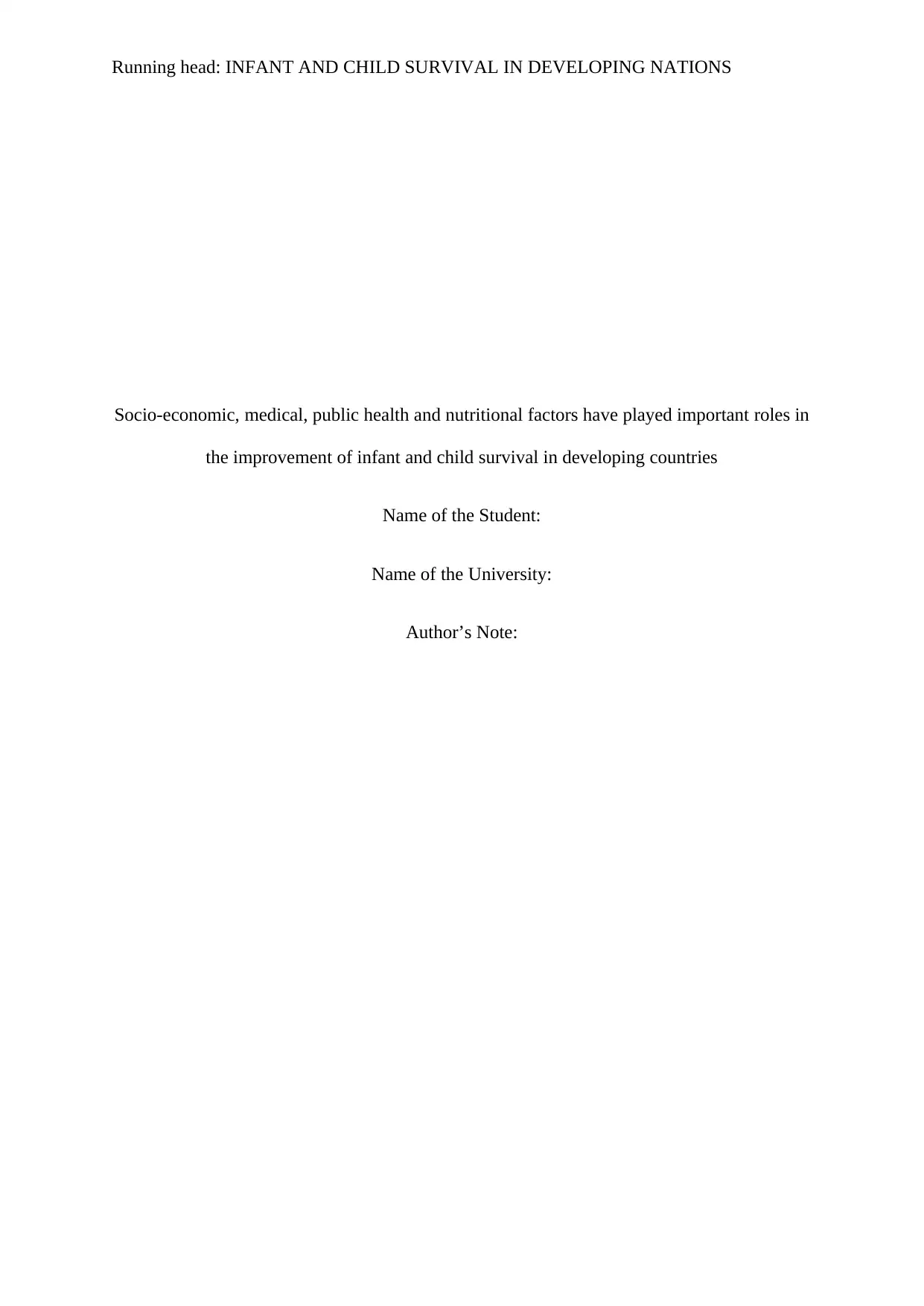
Running head: INFANT AND CHILD SURVIVAL IN DEVELOPING NATIONS
Socio-economic, medical, public health and nutritional factors have played important roles in
the improvement of infant and child survival in developing countries
Name of the Student:
Name of the University:
Author’s Note:
Socio-economic, medical, public health and nutritional factors have played important roles in
the improvement of infant and child survival in developing countries
Name of the Student:
Name of the University:
Author’s Note:
Paraphrase This Document
Need a fresh take? Get an instant paraphrase of this document with our AI Paraphraser
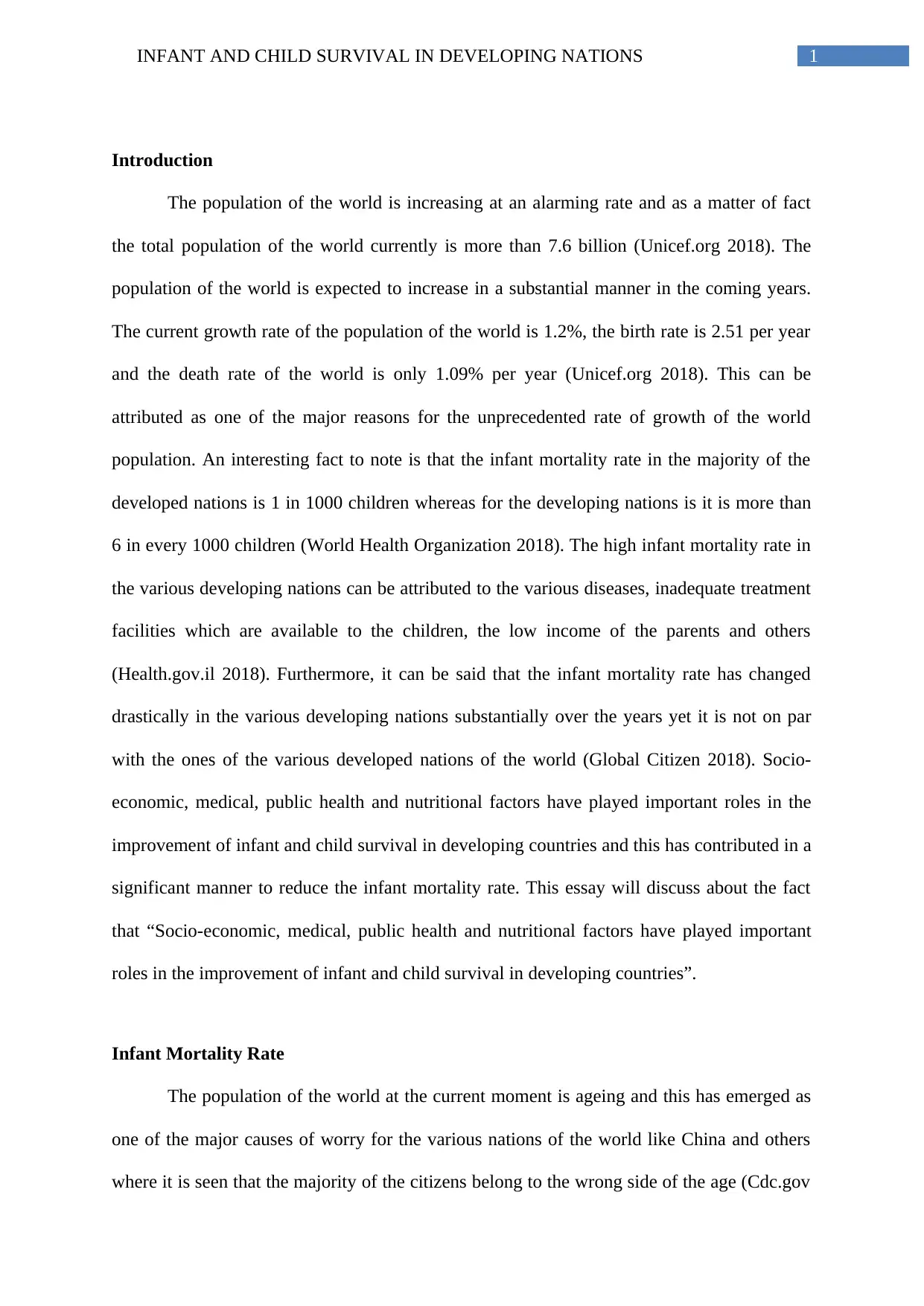
1INFANT AND CHILD SURVIVAL IN DEVELOPING NATIONS
Introduction
The population of the world is increasing at an alarming rate and as a matter of fact
the total population of the world currently is more than 7.6 billion (Unicef.org 2018). The
population of the world is expected to increase in a substantial manner in the coming years.
The current growth rate of the population of the world is 1.2%, the birth rate is 2.51 per year
and the death rate of the world is only 1.09% per year (Unicef.org 2018). This can be
attributed as one of the major reasons for the unprecedented rate of growth of the world
population. An interesting fact to note is that the infant mortality rate in the majority of the
developed nations is 1 in 1000 children whereas for the developing nations is it is more than
6 in every 1000 children (World Health Organization 2018). The high infant mortality rate in
the various developing nations can be attributed to the various diseases, inadequate treatment
facilities which are available to the children, the low income of the parents and others
(Health.gov.il 2018). Furthermore, it can be said that the infant mortality rate has changed
drastically in the various developing nations substantially over the years yet it is not on par
with the ones of the various developed nations of the world (Global Citizen 2018). Socio-
economic, medical, public health and nutritional factors have played important roles in the
improvement of infant and child survival in developing countries and this has contributed in a
significant manner to reduce the infant mortality rate. This essay will discuss about the fact
that “Socio-economic, medical, public health and nutritional factors have played important
roles in the improvement of infant and child survival in developing countries”.
Infant Mortality Rate
The population of the world at the current moment is ageing and this has emerged as
one of the major causes of worry for the various nations of the world like China and others
where it is seen that the majority of the citizens belong to the wrong side of the age (Cdc.gov
Introduction
The population of the world is increasing at an alarming rate and as a matter of fact
the total population of the world currently is more than 7.6 billion (Unicef.org 2018). The
population of the world is expected to increase in a substantial manner in the coming years.
The current growth rate of the population of the world is 1.2%, the birth rate is 2.51 per year
and the death rate of the world is only 1.09% per year (Unicef.org 2018). This can be
attributed as one of the major reasons for the unprecedented rate of growth of the world
population. An interesting fact to note is that the infant mortality rate in the majority of the
developed nations is 1 in 1000 children whereas for the developing nations is it is more than
6 in every 1000 children (World Health Organization 2018). The high infant mortality rate in
the various developing nations can be attributed to the various diseases, inadequate treatment
facilities which are available to the children, the low income of the parents and others
(Health.gov.il 2018). Furthermore, it can be said that the infant mortality rate has changed
drastically in the various developing nations substantially over the years yet it is not on par
with the ones of the various developed nations of the world (Global Citizen 2018). Socio-
economic, medical, public health and nutritional factors have played important roles in the
improvement of infant and child survival in developing countries and this has contributed in a
significant manner to reduce the infant mortality rate. This essay will discuss about the fact
that “Socio-economic, medical, public health and nutritional factors have played important
roles in the improvement of infant and child survival in developing countries”.
Infant Mortality Rate
The population of the world at the current moment is ageing and this has emerged as
one of the major causes of worry for the various nations of the world like China and others
where it is seen that the majority of the citizens belong to the wrong side of the age (Cdc.gov
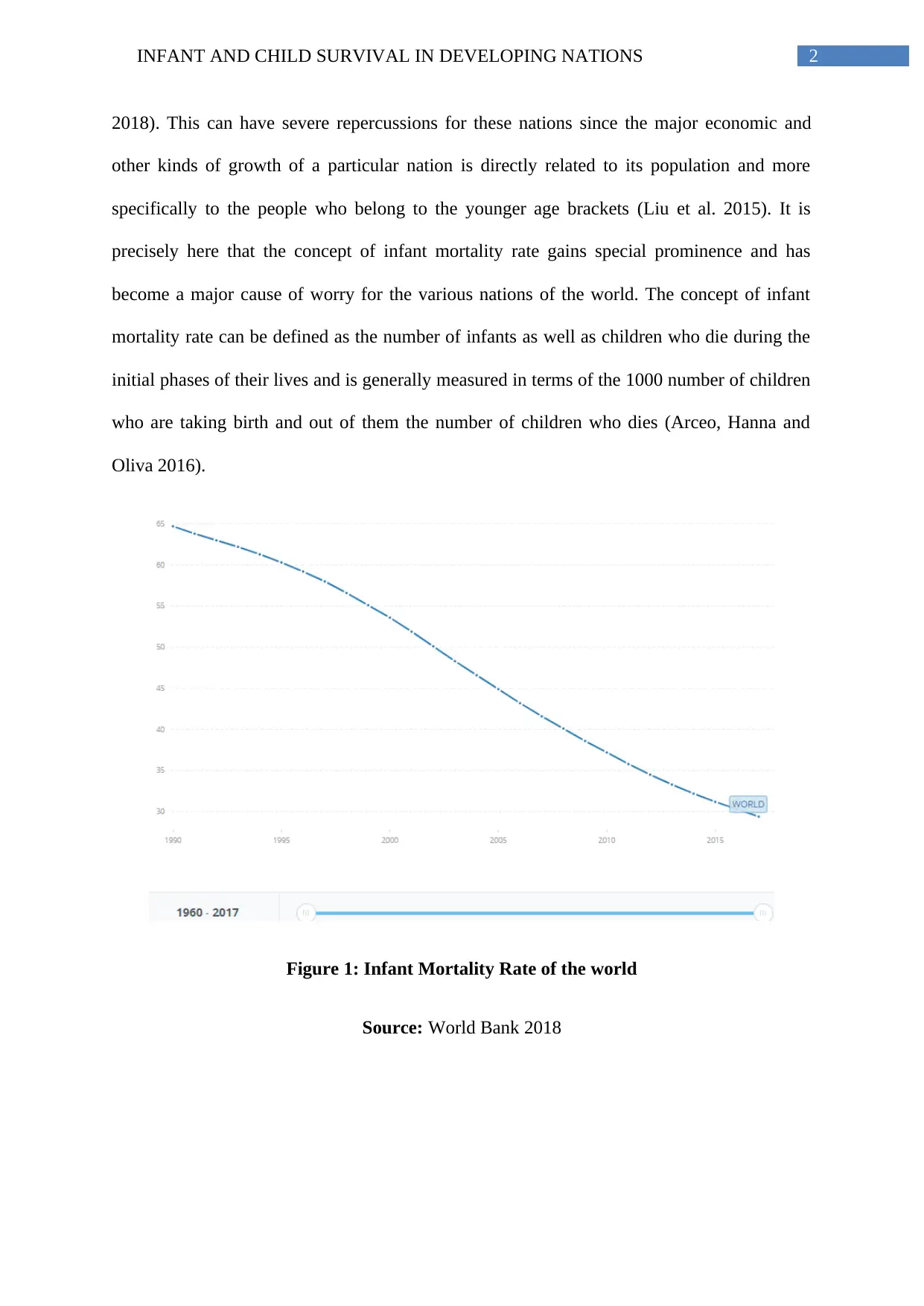
2INFANT AND CHILD SURVIVAL IN DEVELOPING NATIONS
2018). This can have severe repercussions for these nations since the major economic and
other kinds of growth of a particular nation is directly related to its population and more
specifically to the people who belong to the younger age brackets (Liu et al. 2015). It is
precisely here that the concept of infant mortality rate gains special prominence and has
become a major cause of worry for the various nations of the world. The concept of infant
mortality rate can be defined as the number of infants as well as children who die during the
initial phases of their lives and is generally measured in terms of the 1000 number of children
who are taking birth and out of them the number of children who dies (Arceo, Hanna and
Oliva 2016).
Figure 1: Infant Mortality Rate of the world
Source: World Bank 2018
2018). This can have severe repercussions for these nations since the major economic and
other kinds of growth of a particular nation is directly related to its population and more
specifically to the people who belong to the younger age brackets (Liu et al. 2015). It is
precisely here that the concept of infant mortality rate gains special prominence and has
become a major cause of worry for the various nations of the world. The concept of infant
mortality rate can be defined as the number of infants as well as children who die during the
initial phases of their lives and is generally measured in terms of the 1000 number of children
who are taking birth and out of them the number of children who dies (Arceo, Hanna and
Oliva 2016).
Figure 1: Infant Mortality Rate of the world
Source: World Bank 2018
⊘ This is a preview!⊘
Do you want full access?
Subscribe today to unlock all pages.

Trusted by 1+ million students worldwide
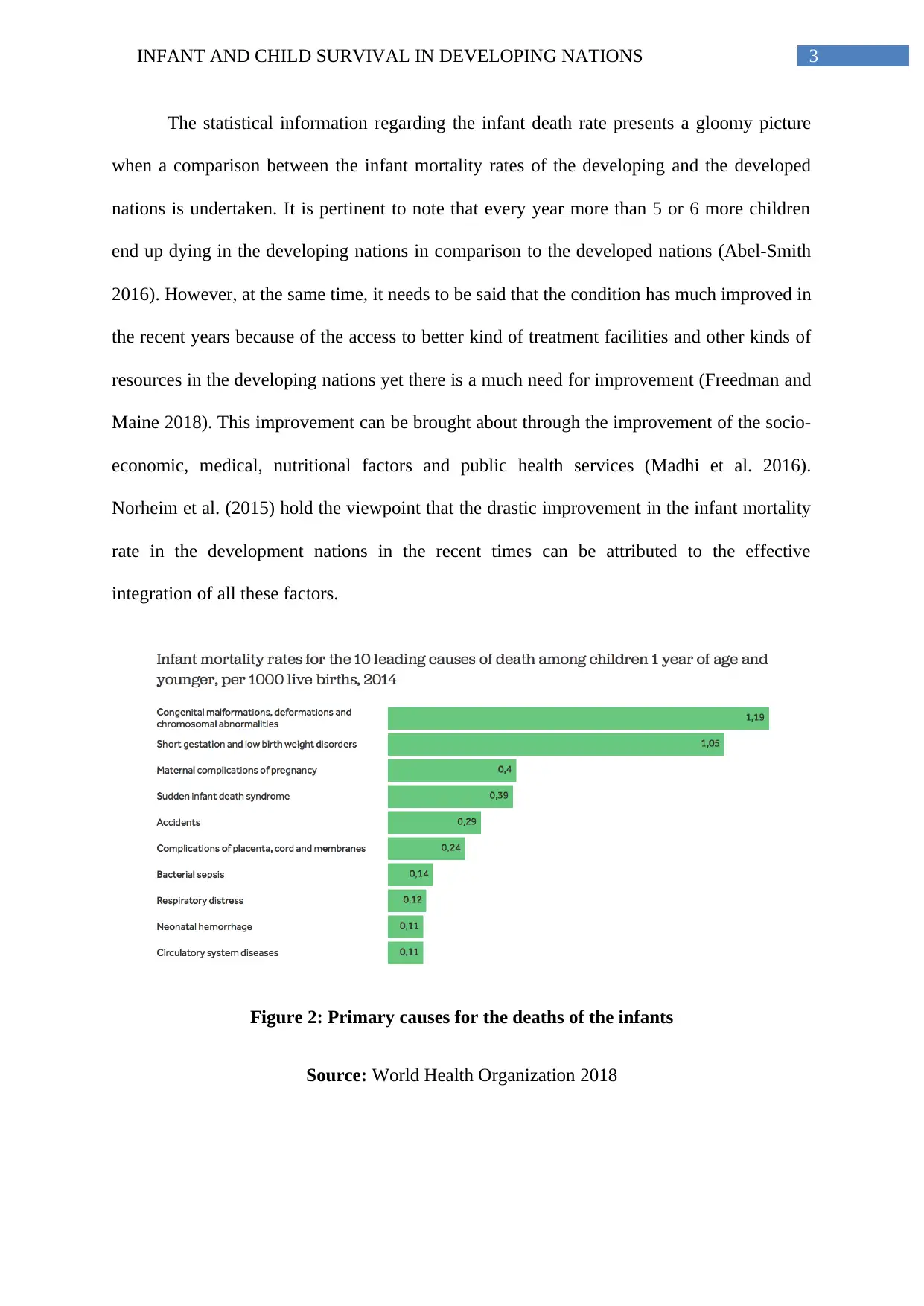
3INFANT AND CHILD SURVIVAL IN DEVELOPING NATIONS
The statistical information regarding the infant death rate presents a gloomy picture
when a comparison between the infant mortality rates of the developing and the developed
nations is undertaken. It is pertinent to note that every year more than 5 or 6 more children
end up dying in the developing nations in comparison to the developed nations (Abel-Smith
2016). However, at the same time, it needs to be said that the condition has much improved in
the recent years because of the access to better kind of treatment facilities and other kinds of
resources in the developing nations yet there is a much need for improvement (Freedman and
Maine 2018). This improvement can be brought about through the improvement of the socio-
economic, medical, nutritional factors and public health services (Madhi et al. 2016).
Norheim et al. (2015) hold the viewpoint that the drastic improvement in the infant mortality
rate in the development nations in the recent times can be attributed to the effective
integration of all these factors.
Figure 2: Primary causes for the deaths of the infants
Source: World Health Organization 2018
The statistical information regarding the infant death rate presents a gloomy picture
when a comparison between the infant mortality rates of the developing and the developed
nations is undertaken. It is pertinent to note that every year more than 5 or 6 more children
end up dying in the developing nations in comparison to the developed nations (Abel-Smith
2016). However, at the same time, it needs to be said that the condition has much improved in
the recent years because of the access to better kind of treatment facilities and other kinds of
resources in the developing nations yet there is a much need for improvement (Freedman and
Maine 2018). This improvement can be brought about through the improvement of the socio-
economic, medical, nutritional factors and public health services (Madhi et al. 2016).
Norheim et al. (2015) hold the viewpoint that the drastic improvement in the infant mortality
rate in the development nations in the recent times can be attributed to the effective
integration of all these factors.
Figure 2: Primary causes for the deaths of the infants
Source: World Health Organization 2018
Paraphrase This Document
Need a fresh take? Get an instant paraphrase of this document with our AI Paraphraser
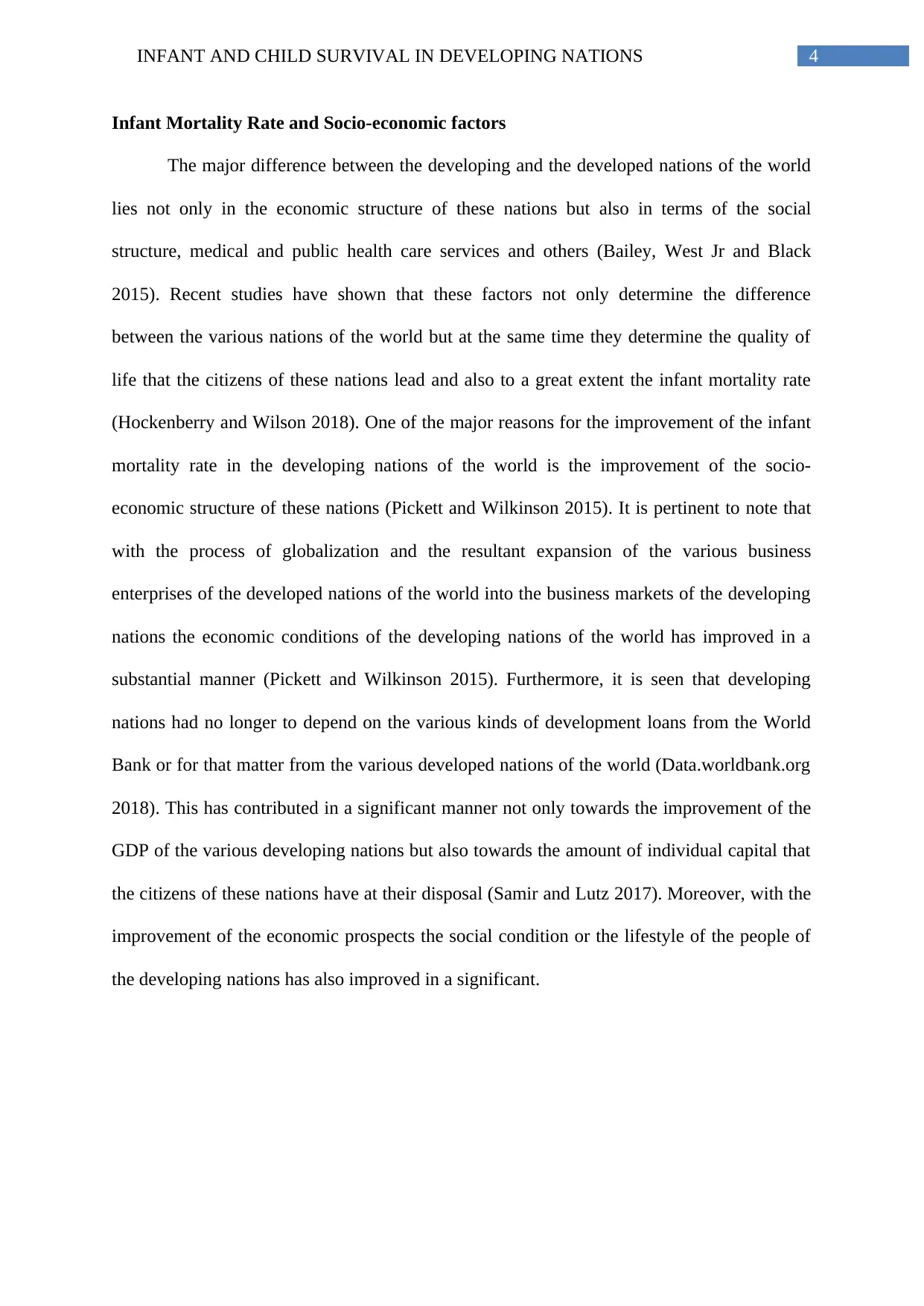
4INFANT AND CHILD SURVIVAL IN DEVELOPING NATIONS
Infant Mortality Rate and Socio-economic factors
The major difference between the developing and the developed nations of the world
lies not only in the economic structure of these nations but also in terms of the social
structure, medical and public health care services and others (Bailey, West Jr and Black
2015). Recent studies have shown that these factors not only determine the difference
between the various nations of the world but at the same time they determine the quality of
life that the citizens of these nations lead and also to a great extent the infant mortality rate
(Hockenberry and Wilson 2018). One of the major reasons for the improvement of the infant
mortality rate in the developing nations of the world is the improvement of the socio-
economic structure of these nations (Pickett and Wilkinson 2015). It is pertinent to note that
with the process of globalization and the resultant expansion of the various business
enterprises of the developed nations of the world into the business markets of the developing
nations the economic conditions of the developing nations of the world has improved in a
substantial manner (Pickett and Wilkinson 2015). Furthermore, it is seen that developing
nations had no longer to depend on the various kinds of development loans from the World
Bank or for that matter from the various developed nations of the world (Data.worldbank.org
2018). This has contributed in a significant manner not only towards the improvement of the
GDP of the various developing nations but also towards the amount of individual capital that
the citizens of these nations have at their disposal (Samir and Lutz 2017). Moreover, with the
improvement of the economic prospects the social condition or the lifestyle of the people of
the developing nations has also improved in a significant.
Infant Mortality Rate and Socio-economic factors
The major difference between the developing and the developed nations of the world
lies not only in the economic structure of these nations but also in terms of the social
structure, medical and public health care services and others (Bailey, West Jr and Black
2015). Recent studies have shown that these factors not only determine the difference
between the various nations of the world but at the same time they determine the quality of
life that the citizens of these nations lead and also to a great extent the infant mortality rate
(Hockenberry and Wilson 2018). One of the major reasons for the improvement of the infant
mortality rate in the developing nations of the world is the improvement of the socio-
economic structure of these nations (Pickett and Wilkinson 2015). It is pertinent to note that
with the process of globalization and the resultant expansion of the various business
enterprises of the developed nations of the world into the business markets of the developing
nations the economic conditions of the developing nations of the world has improved in a
substantial manner (Pickett and Wilkinson 2015). Furthermore, it is seen that developing
nations had no longer to depend on the various kinds of development loans from the World
Bank or for that matter from the various developed nations of the world (Data.worldbank.org
2018). This has contributed in a significant manner not only towards the improvement of the
GDP of the various developing nations but also towards the amount of individual capital that
the citizens of these nations have at their disposal (Samir and Lutz 2017). Moreover, with the
improvement of the economic prospects the social condition or the lifestyle of the people of
the developing nations has also improved in a significant.
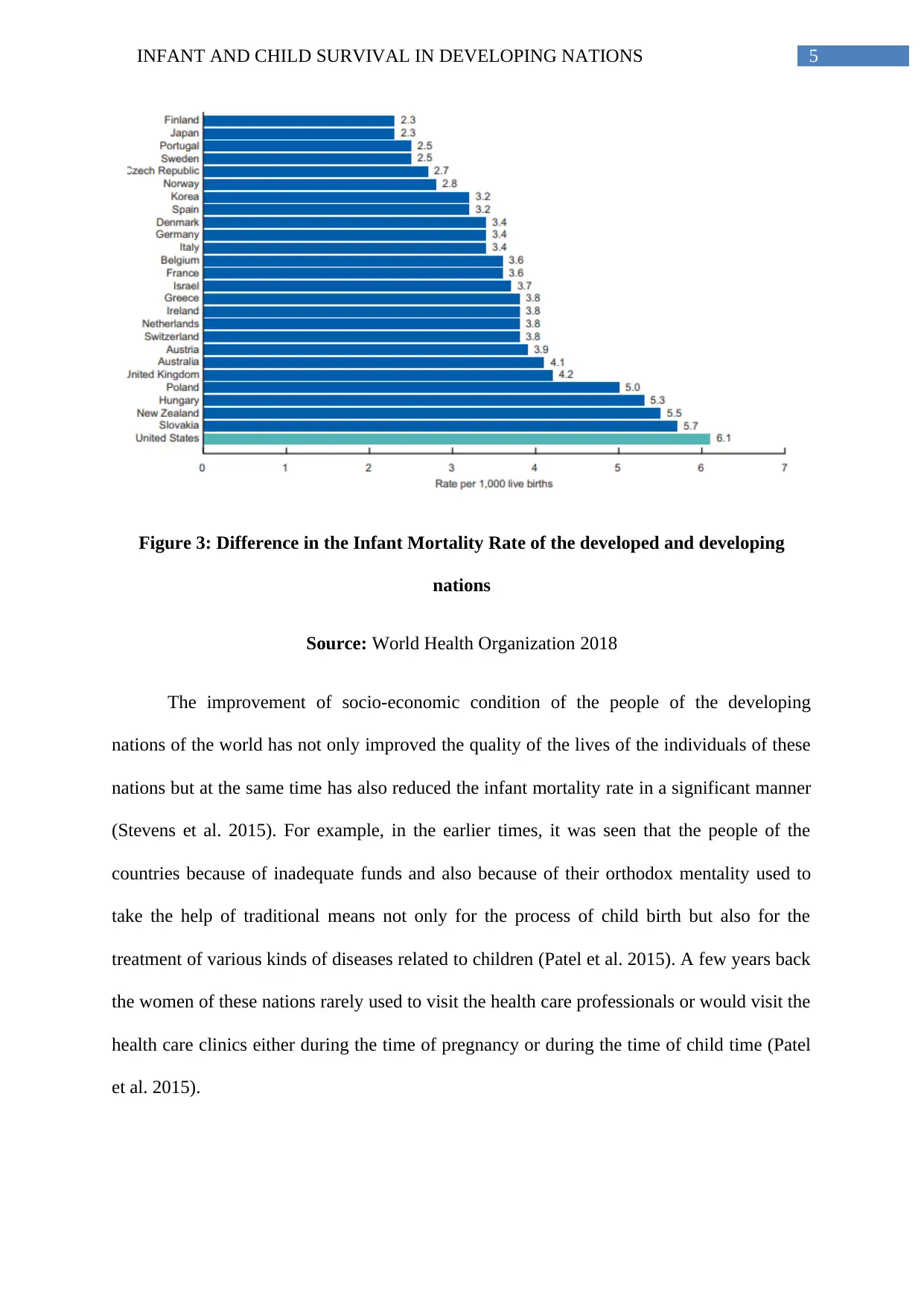
5INFANT AND CHILD SURVIVAL IN DEVELOPING NATIONS
Figure 3: Difference in the Infant Mortality Rate of the developed and developing
nations
Source: World Health Organization 2018
The improvement of socio-economic condition of the people of the developing
nations of the world has not only improved the quality of the lives of the individuals of these
nations but at the same time has also reduced the infant mortality rate in a significant manner
(Stevens et al. 2015). For example, in the earlier times, it was seen that the people of the
countries because of inadequate funds and also because of their orthodox mentality used to
take the help of traditional means not only for the process of child birth but also for the
treatment of various kinds of diseases related to children (Patel et al. 2015). A few years back
the women of these nations rarely used to visit the health care professionals or would visit the
health care clinics either during the time of pregnancy or during the time of child time (Patel
et al. 2015).
Figure 3: Difference in the Infant Mortality Rate of the developed and developing
nations
Source: World Health Organization 2018
The improvement of socio-economic condition of the people of the developing
nations of the world has not only improved the quality of the lives of the individuals of these
nations but at the same time has also reduced the infant mortality rate in a significant manner
(Stevens et al. 2015). For example, in the earlier times, it was seen that the people of the
countries because of inadequate funds and also because of their orthodox mentality used to
take the help of traditional means not only for the process of child birth but also for the
treatment of various kinds of diseases related to children (Patel et al. 2015). A few years back
the women of these nations rarely used to visit the health care professionals or would visit the
health care clinics either during the time of pregnancy or during the time of child time (Patel
et al. 2015).
⊘ This is a preview!⊘
Do you want full access?
Subscribe today to unlock all pages.

Trusted by 1+ million students worldwide
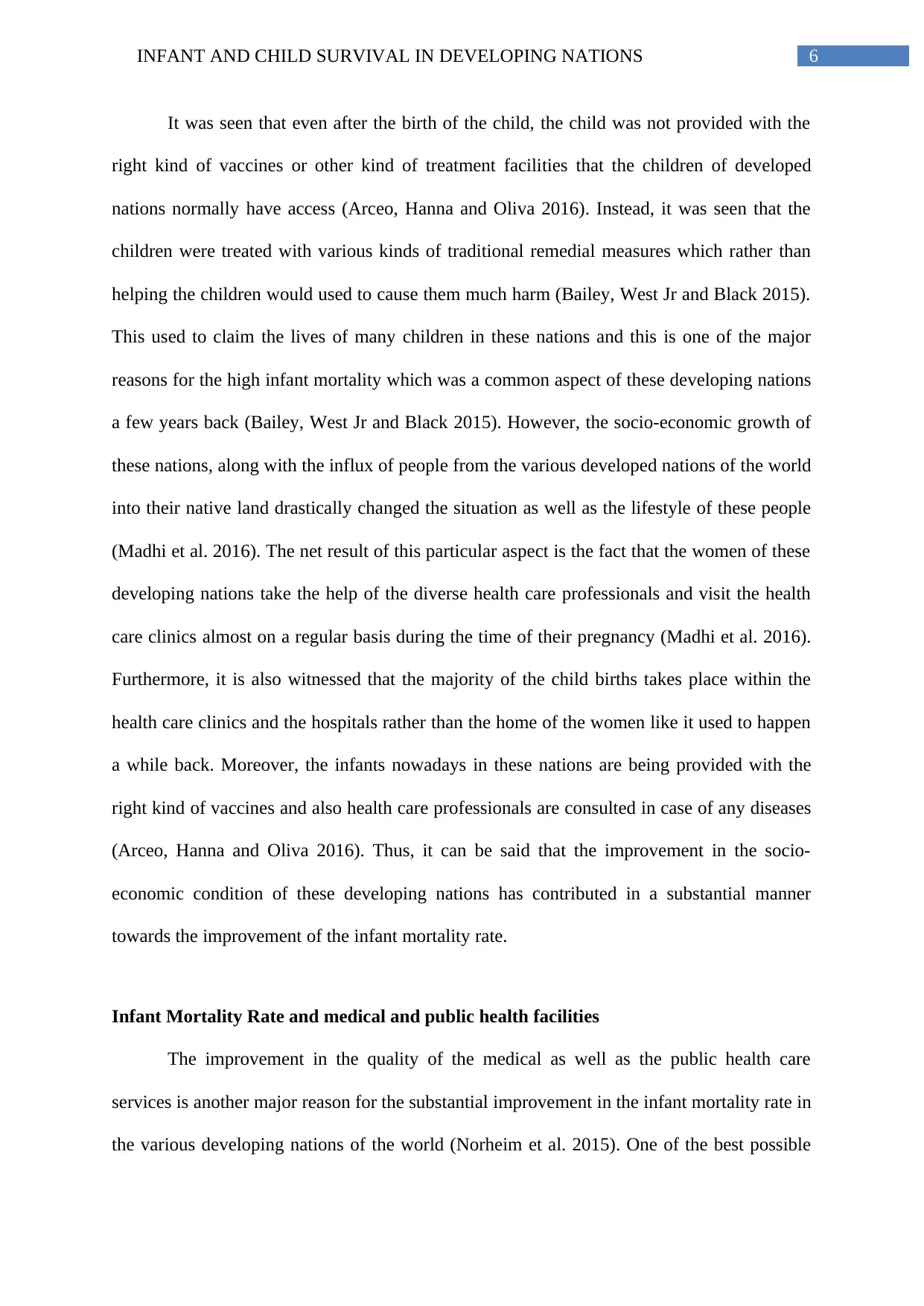
6INFANT AND CHILD SURVIVAL IN DEVELOPING NATIONS
It was seen that even after the birth of the child, the child was not provided with the
right kind of vaccines or other kind of treatment facilities that the children of developed
nations normally have access (Arceo, Hanna and Oliva 2016). Instead, it was seen that the
children were treated with various kinds of traditional remedial measures which rather than
helping the children would used to cause them much harm (Bailey, West Jr and Black 2015).
This used to claim the lives of many children in these nations and this is one of the major
reasons for the high infant mortality which was a common aspect of these developing nations
a few years back (Bailey, West Jr and Black 2015). However, the socio-economic growth of
these nations, along with the influx of people from the various developed nations of the world
into their native land drastically changed the situation as well as the lifestyle of these people
(Madhi et al. 2016). The net result of this particular aspect is the fact that the women of these
developing nations take the help of the diverse health care professionals and visit the health
care clinics almost on a regular basis during the time of their pregnancy (Madhi et al. 2016).
Furthermore, it is also witnessed that the majority of the child births takes place within the
health care clinics and the hospitals rather than the home of the women like it used to happen
a while back. Moreover, the infants nowadays in these nations are being provided with the
right kind of vaccines and also health care professionals are consulted in case of any diseases
(Arceo, Hanna and Oliva 2016). Thus, it can be said that the improvement in the socio-
economic condition of these developing nations has contributed in a substantial manner
towards the improvement of the infant mortality rate.
Infant Mortality Rate and medical and public health facilities
The improvement in the quality of the medical as well as the public health care
services is another major reason for the substantial improvement in the infant mortality rate in
the various developing nations of the world (Norheim et al. 2015). One of the best possible
It was seen that even after the birth of the child, the child was not provided with the
right kind of vaccines or other kind of treatment facilities that the children of developed
nations normally have access (Arceo, Hanna and Oliva 2016). Instead, it was seen that the
children were treated with various kinds of traditional remedial measures which rather than
helping the children would used to cause them much harm (Bailey, West Jr and Black 2015).
This used to claim the lives of many children in these nations and this is one of the major
reasons for the high infant mortality which was a common aspect of these developing nations
a few years back (Bailey, West Jr and Black 2015). However, the socio-economic growth of
these nations, along with the influx of people from the various developed nations of the world
into their native land drastically changed the situation as well as the lifestyle of these people
(Madhi et al. 2016). The net result of this particular aspect is the fact that the women of these
developing nations take the help of the diverse health care professionals and visit the health
care clinics almost on a regular basis during the time of their pregnancy (Madhi et al. 2016).
Furthermore, it is also witnessed that the majority of the child births takes place within the
health care clinics and the hospitals rather than the home of the women like it used to happen
a while back. Moreover, the infants nowadays in these nations are being provided with the
right kind of vaccines and also health care professionals are consulted in case of any diseases
(Arceo, Hanna and Oliva 2016). Thus, it can be said that the improvement in the socio-
economic condition of these developing nations has contributed in a substantial manner
towards the improvement of the infant mortality rate.
Infant Mortality Rate and medical and public health facilities
The improvement in the quality of the medical as well as the public health care
services is another major reason for the substantial improvement in the infant mortality rate in
the various developing nations of the world (Norheim et al. 2015). One of the best possible
Paraphrase This Document
Need a fresh take? Get an instant paraphrase of this document with our AI Paraphraser
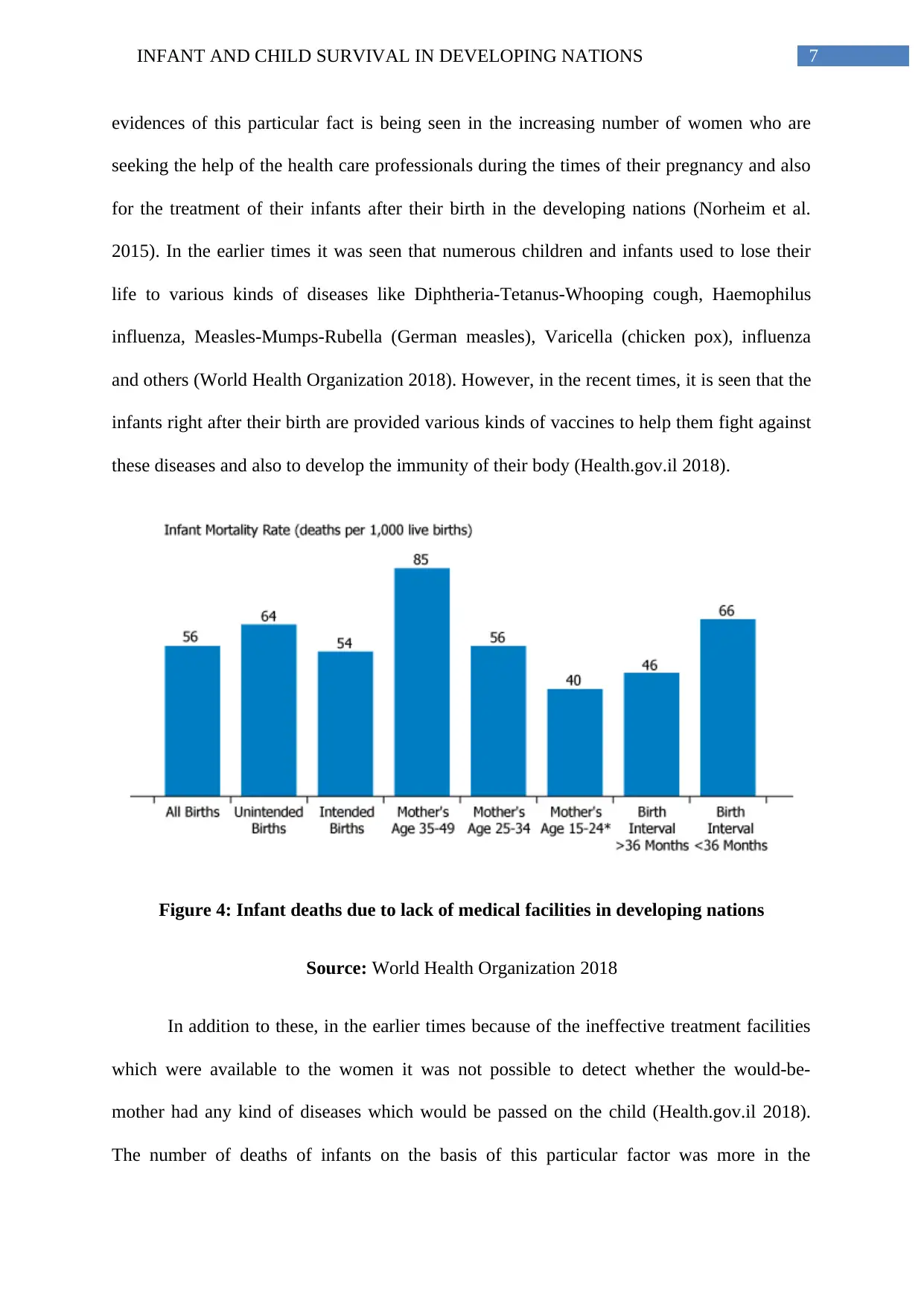
7INFANT AND CHILD SURVIVAL IN DEVELOPING NATIONS
evidences of this particular fact is being seen in the increasing number of women who are
seeking the help of the health care professionals during the times of their pregnancy and also
for the treatment of their infants after their birth in the developing nations (Norheim et al.
2015). In the earlier times it was seen that numerous children and infants used to lose their
life to various kinds of diseases like Diphtheria-Tetanus-Whooping cough, Haemophilus
influenza, Measles-Mumps-Rubella (German measles), Varicella (chicken pox), influenza
and others (World Health Organization 2018). However, in the recent times, it is seen that the
infants right after their birth are provided various kinds of vaccines to help them fight against
these diseases and also to develop the immunity of their body (Health.gov.il 2018).
Figure 4: Infant deaths due to lack of medical facilities in developing nations
Source: World Health Organization 2018
In addition to these, in the earlier times because of the ineffective treatment facilities
which were available to the women it was not possible to detect whether the would-be-
mother had any kind of diseases which would be passed on the child (Health.gov.il 2018).
The number of deaths of infants on the basis of this particular factor was more in the
evidences of this particular fact is being seen in the increasing number of women who are
seeking the help of the health care professionals during the times of their pregnancy and also
for the treatment of their infants after their birth in the developing nations (Norheim et al.
2015). In the earlier times it was seen that numerous children and infants used to lose their
life to various kinds of diseases like Diphtheria-Tetanus-Whooping cough, Haemophilus
influenza, Measles-Mumps-Rubella (German measles), Varicella (chicken pox), influenza
and others (World Health Organization 2018). However, in the recent times, it is seen that the
infants right after their birth are provided various kinds of vaccines to help them fight against
these diseases and also to develop the immunity of their body (Health.gov.il 2018).
Figure 4: Infant deaths due to lack of medical facilities in developing nations
Source: World Health Organization 2018
In addition to these, in the earlier times because of the ineffective treatment facilities
which were available to the women it was not possible to detect whether the would-be-
mother had any kind of diseases which would be passed on the child (Health.gov.il 2018).
The number of deaths of infants on the basis of this particular factor was more in the
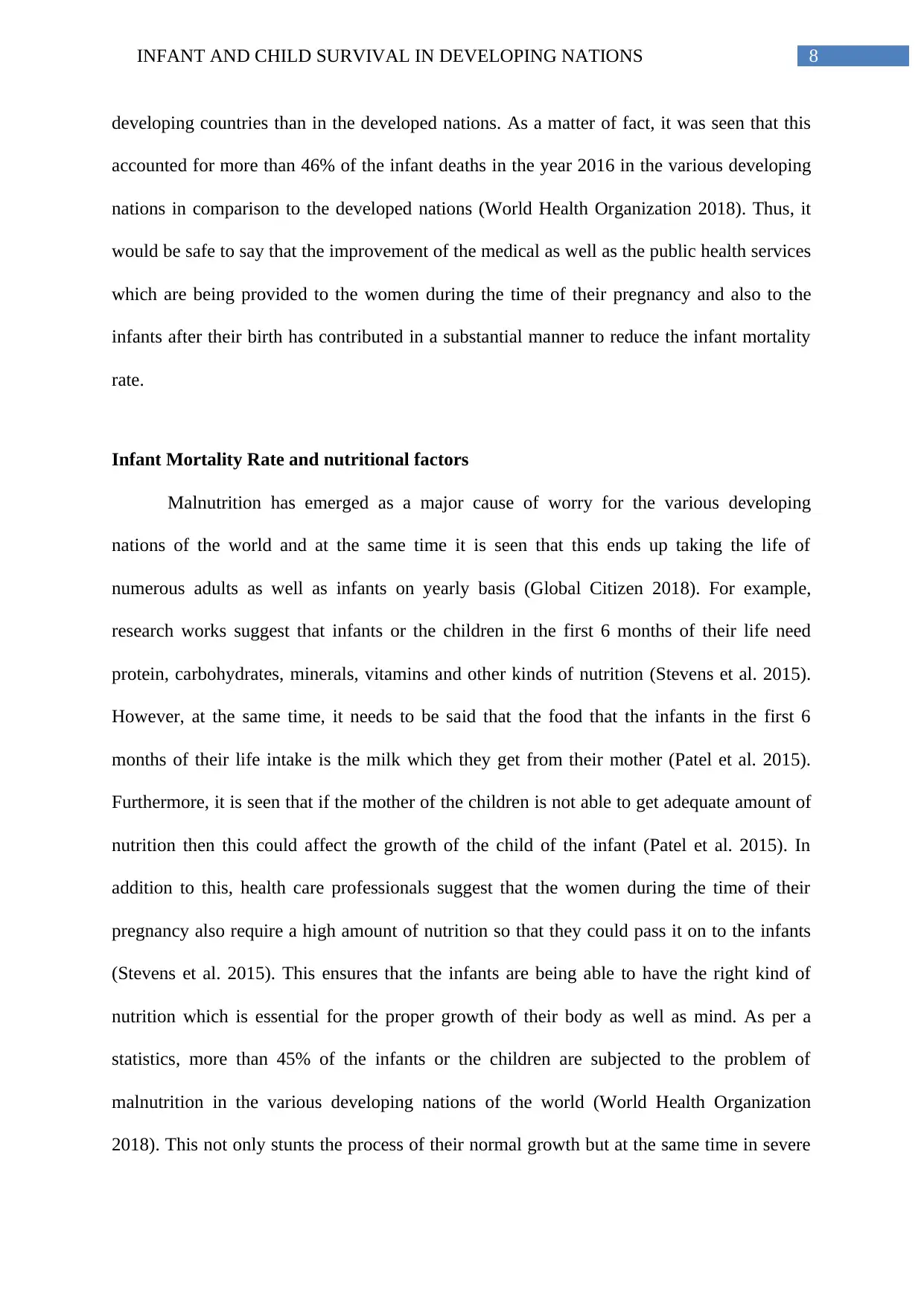
8INFANT AND CHILD SURVIVAL IN DEVELOPING NATIONS
developing countries than in the developed nations. As a matter of fact, it was seen that this
accounted for more than 46% of the infant deaths in the year 2016 in the various developing
nations in comparison to the developed nations (World Health Organization 2018). Thus, it
would be safe to say that the improvement of the medical as well as the public health services
which are being provided to the women during the time of their pregnancy and also to the
infants after their birth has contributed in a substantial manner to reduce the infant mortality
rate.
Infant Mortality Rate and nutritional factors
Malnutrition has emerged as a major cause of worry for the various developing
nations of the world and at the same time it is seen that this ends up taking the life of
numerous adults as well as infants on yearly basis (Global Citizen 2018). For example,
research works suggest that infants or the children in the first 6 months of their life need
protein, carbohydrates, minerals, vitamins and other kinds of nutrition (Stevens et al. 2015).
However, at the same time, it needs to be said that the food that the infants in the first 6
months of their life intake is the milk which they get from their mother (Patel et al. 2015).
Furthermore, it is seen that if the mother of the children is not able to get adequate amount of
nutrition then this could affect the growth of the child of the infant (Patel et al. 2015). In
addition to this, health care professionals suggest that the women during the time of their
pregnancy also require a high amount of nutrition so that they could pass it on to the infants
(Stevens et al. 2015). This ensures that the infants are being able to have the right kind of
nutrition which is essential for the proper growth of their body as well as mind. As per a
statistics, more than 45% of the infants or the children are subjected to the problem of
malnutrition in the various developing nations of the world (World Health Organization
2018). This not only stunts the process of their normal growth but at the same time in severe
developing countries than in the developed nations. As a matter of fact, it was seen that this
accounted for more than 46% of the infant deaths in the year 2016 in the various developing
nations in comparison to the developed nations (World Health Organization 2018). Thus, it
would be safe to say that the improvement of the medical as well as the public health services
which are being provided to the women during the time of their pregnancy and also to the
infants after their birth has contributed in a substantial manner to reduce the infant mortality
rate.
Infant Mortality Rate and nutritional factors
Malnutrition has emerged as a major cause of worry for the various developing
nations of the world and at the same time it is seen that this ends up taking the life of
numerous adults as well as infants on yearly basis (Global Citizen 2018). For example,
research works suggest that infants or the children in the first 6 months of their life need
protein, carbohydrates, minerals, vitamins and other kinds of nutrition (Stevens et al. 2015).
However, at the same time, it needs to be said that the food that the infants in the first 6
months of their life intake is the milk which they get from their mother (Patel et al. 2015).
Furthermore, it is seen that if the mother of the children is not able to get adequate amount of
nutrition then this could affect the growth of the child of the infant (Patel et al. 2015). In
addition to this, health care professionals suggest that the women during the time of their
pregnancy also require a high amount of nutrition so that they could pass it on to the infants
(Stevens et al. 2015). This ensures that the infants are being able to have the right kind of
nutrition which is essential for the proper growth of their body as well as mind. As per a
statistics, more than 45% of the infants or the children are subjected to the problem of
malnutrition in the various developing nations of the world (World Health Organization
2018). This not only stunts the process of their normal growth but at the same time in severe
⊘ This is a preview!⊘
Do you want full access?
Subscribe today to unlock all pages.

Trusted by 1+ million students worldwide
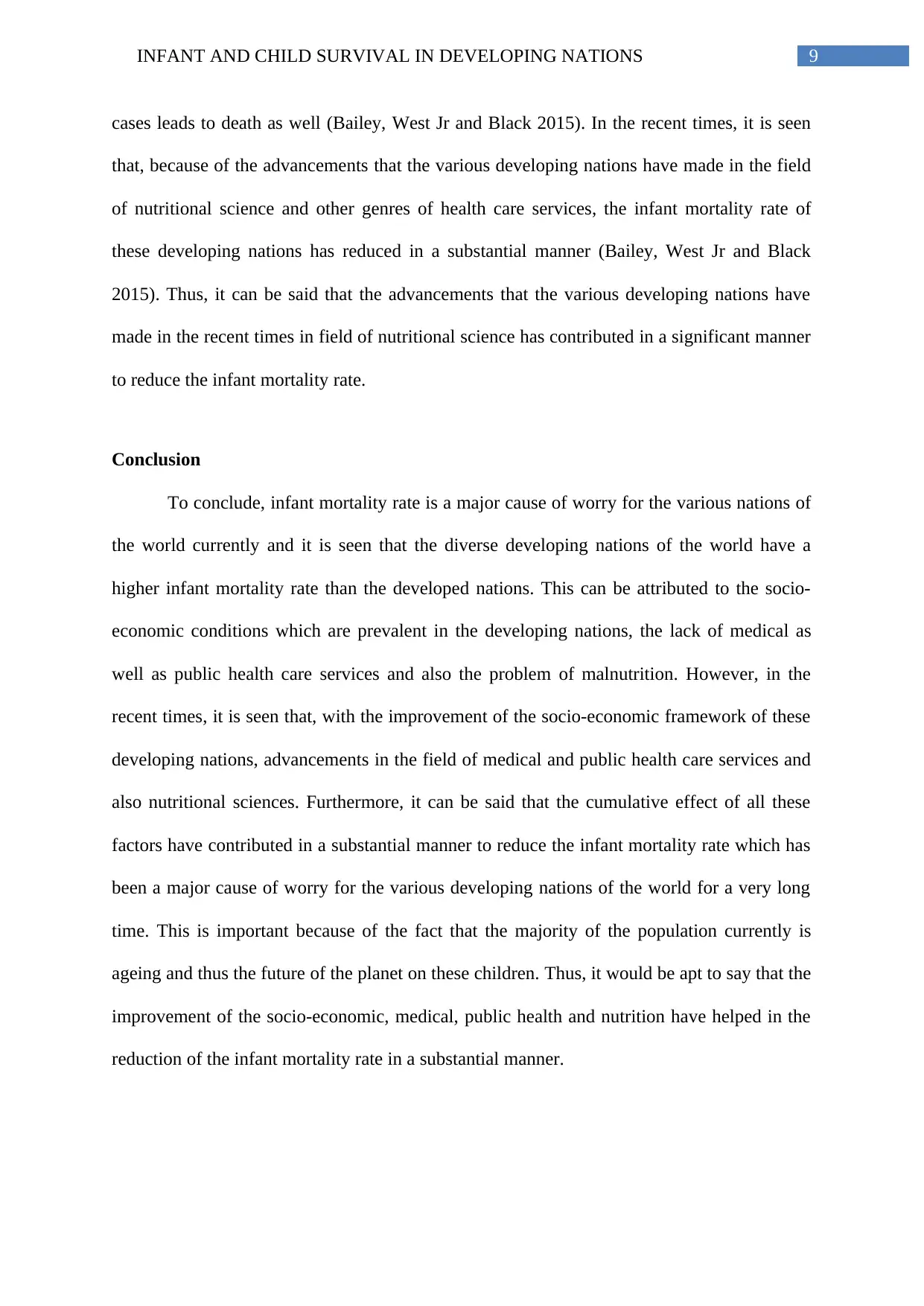
9INFANT AND CHILD SURVIVAL IN DEVELOPING NATIONS
cases leads to death as well (Bailey, West Jr and Black 2015). In the recent times, it is seen
that, because of the advancements that the various developing nations have made in the field
of nutritional science and other genres of health care services, the infant mortality rate of
these developing nations has reduced in a substantial manner (Bailey, West Jr and Black
2015). Thus, it can be said that the advancements that the various developing nations have
made in the recent times in field of nutritional science has contributed in a significant manner
to reduce the infant mortality rate.
Conclusion
To conclude, infant mortality rate is a major cause of worry for the various nations of
the world currently and it is seen that the diverse developing nations of the world have a
higher infant mortality rate than the developed nations. This can be attributed to the socio-
economic conditions which are prevalent in the developing nations, the lack of medical as
well as public health care services and also the problem of malnutrition. However, in the
recent times, it is seen that, with the improvement of the socio-economic framework of these
developing nations, advancements in the field of medical and public health care services and
also nutritional sciences. Furthermore, it can be said that the cumulative effect of all these
factors have contributed in a substantial manner to reduce the infant mortality rate which has
been a major cause of worry for the various developing nations of the world for a very long
time. This is important because of the fact that the majority of the population currently is
ageing and thus the future of the planet on these children. Thus, it would be apt to say that the
improvement of the socio-economic, medical, public health and nutrition have helped in the
reduction of the infant mortality rate in a substantial manner.
cases leads to death as well (Bailey, West Jr and Black 2015). In the recent times, it is seen
that, because of the advancements that the various developing nations have made in the field
of nutritional science and other genres of health care services, the infant mortality rate of
these developing nations has reduced in a substantial manner (Bailey, West Jr and Black
2015). Thus, it can be said that the advancements that the various developing nations have
made in the recent times in field of nutritional science has contributed in a significant manner
to reduce the infant mortality rate.
Conclusion
To conclude, infant mortality rate is a major cause of worry for the various nations of
the world currently and it is seen that the diverse developing nations of the world have a
higher infant mortality rate than the developed nations. This can be attributed to the socio-
economic conditions which are prevalent in the developing nations, the lack of medical as
well as public health care services and also the problem of malnutrition. However, in the
recent times, it is seen that, with the improvement of the socio-economic framework of these
developing nations, advancements in the field of medical and public health care services and
also nutritional sciences. Furthermore, it can be said that the cumulative effect of all these
factors have contributed in a substantial manner to reduce the infant mortality rate which has
been a major cause of worry for the various developing nations of the world for a very long
time. This is important because of the fact that the majority of the population currently is
ageing and thus the future of the planet on these children. Thus, it would be apt to say that the
improvement of the socio-economic, medical, public health and nutrition have helped in the
reduction of the infant mortality rate in a substantial manner.
Paraphrase This Document
Need a fresh take? Get an instant paraphrase of this document with our AI Paraphraser
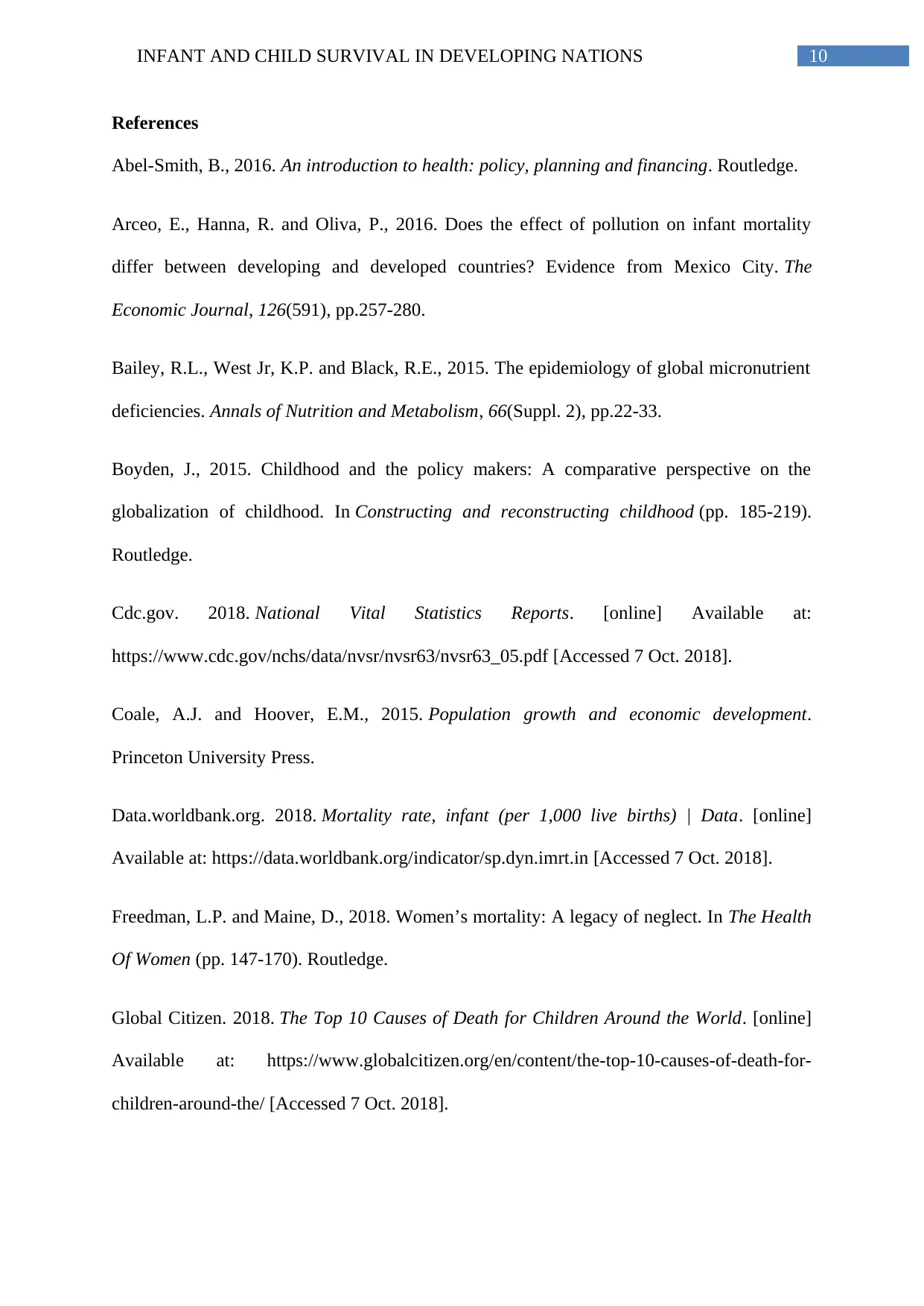
10INFANT AND CHILD SURVIVAL IN DEVELOPING NATIONS
References
Abel-Smith, B., 2016. An introduction to health: policy, planning and financing. Routledge.
Arceo, E., Hanna, R. and Oliva, P., 2016. Does the effect of pollution on infant mortality
differ between developing and developed countries? Evidence from Mexico City. The
Economic Journal, 126(591), pp.257-280.
Bailey, R.L., West Jr, K.P. and Black, R.E., 2015. The epidemiology of global micronutrient
deficiencies. Annals of Nutrition and Metabolism, 66(Suppl. 2), pp.22-33.
Boyden, J., 2015. Childhood and the policy makers: A comparative perspective on the
globalization of childhood. In Constructing and reconstructing childhood (pp. 185-219).
Routledge.
Cdc.gov. 2018. National Vital Statistics Reports. [online] Available at:
https://www.cdc.gov/nchs/data/nvsr/nvsr63/nvsr63_05.pdf [Accessed 7 Oct. 2018].
Coale, A.J. and Hoover, E.M., 2015. Population growth and economic development.
Princeton University Press.
Data.worldbank.org. 2018. Mortality rate, infant (per 1,000 live births) | Data. [online]
Available at: https://data.worldbank.org/indicator/sp.dyn.imrt.in [Accessed 7 Oct. 2018].
Freedman, L.P. and Maine, D., 2018. Women’s mortality: A legacy of neglect. In The Health
Of Women (pp. 147-170). Routledge.
Global Citizen. 2018. The Top 10 Causes of Death for Children Around the World. [online]
Available at: https://www.globalcitizen.org/en/content/the-top-10-causes-of-death-for-
children-around-the/ [Accessed 7 Oct. 2018].
References
Abel-Smith, B., 2016. An introduction to health: policy, planning and financing. Routledge.
Arceo, E., Hanna, R. and Oliva, P., 2016. Does the effect of pollution on infant mortality
differ between developing and developed countries? Evidence from Mexico City. The
Economic Journal, 126(591), pp.257-280.
Bailey, R.L., West Jr, K.P. and Black, R.E., 2015. The epidemiology of global micronutrient
deficiencies. Annals of Nutrition and Metabolism, 66(Suppl. 2), pp.22-33.
Boyden, J., 2015. Childhood and the policy makers: A comparative perspective on the
globalization of childhood. In Constructing and reconstructing childhood (pp. 185-219).
Routledge.
Cdc.gov. 2018. National Vital Statistics Reports. [online] Available at:
https://www.cdc.gov/nchs/data/nvsr/nvsr63/nvsr63_05.pdf [Accessed 7 Oct. 2018].
Coale, A.J. and Hoover, E.M., 2015. Population growth and economic development.
Princeton University Press.
Data.worldbank.org. 2018. Mortality rate, infant (per 1,000 live births) | Data. [online]
Available at: https://data.worldbank.org/indicator/sp.dyn.imrt.in [Accessed 7 Oct. 2018].
Freedman, L.P. and Maine, D., 2018. Women’s mortality: A legacy of neglect. In The Health
Of Women (pp. 147-170). Routledge.
Global Citizen. 2018. The Top 10 Causes of Death for Children Around the World. [online]
Available at: https://www.globalcitizen.org/en/content/the-top-10-causes-of-death-for-
children-around-the/ [Accessed 7 Oct. 2018].
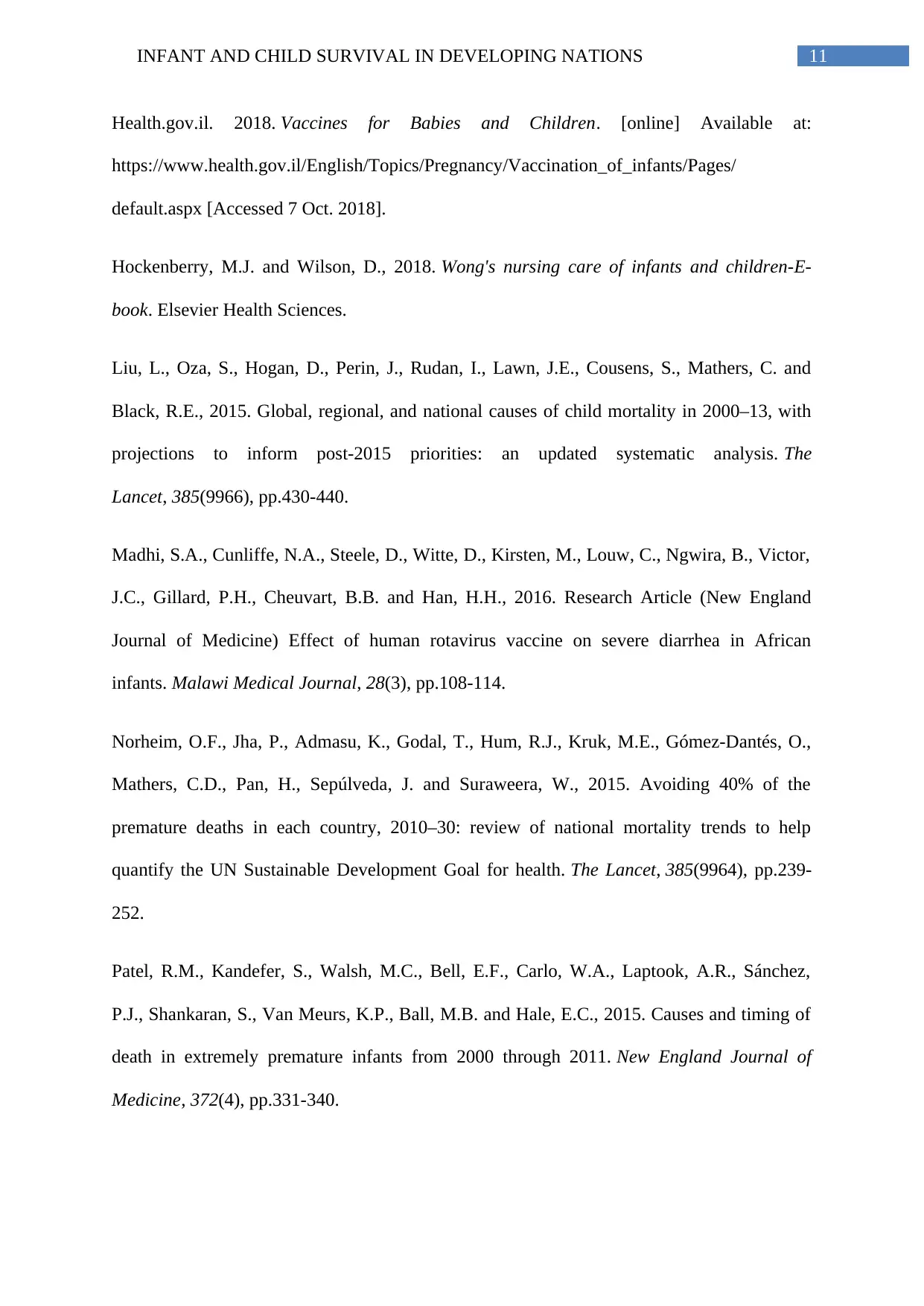
11INFANT AND CHILD SURVIVAL IN DEVELOPING NATIONS
Health.gov.il. 2018. Vaccines for Babies and Children. [online] Available at:
https://www.health.gov.il/English/Topics/Pregnancy/Vaccination_of_infants/Pages/
default.aspx [Accessed 7 Oct. 2018].
Hockenberry, M.J. and Wilson, D., 2018. Wong's nursing care of infants and children-E-
book. Elsevier Health Sciences.
Liu, L., Oza, S., Hogan, D., Perin, J., Rudan, I., Lawn, J.E., Cousens, S., Mathers, C. and
Black, R.E., 2015. Global, regional, and national causes of child mortality in 2000–13, with
projections to inform post-2015 priorities: an updated systematic analysis. The
Lancet, 385(9966), pp.430-440.
Madhi, S.A., Cunliffe, N.A., Steele, D., Witte, D., Kirsten, M., Louw, C., Ngwira, B., Victor,
J.C., Gillard, P.H., Cheuvart, B.B. and Han, H.H., 2016. Research Article (New England
Journal of Medicine) Effect of human rotavirus vaccine on severe diarrhea in African
infants. Malawi Medical Journal, 28(3), pp.108-114.
Norheim, O.F., Jha, P., Admasu, K., Godal, T., Hum, R.J., Kruk, M.E., Gómez-Dantés, O.,
Mathers, C.D., Pan, H., Sepúlveda, J. and Suraweera, W., 2015. Avoiding 40% of the
premature deaths in each country, 2010–30: review of national mortality trends to help
quantify the UN Sustainable Development Goal for health. The Lancet, 385(9964), pp.239-
252.
Patel, R.M., Kandefer, S., Walsh, M.C., Bell, E.F., Carlo, W.A., Laptook, A.R., Sánchez,
P.J., Shankaran, S., Van Meurs, K.P., Ball, M.B. and Hale, E.C., 2015. Causes and timing of
death in extremely premature infants from 2000 through 2011. New England Journal of
Medicine, 372(4), pp.331-340.
Health.gov.il. 2018. Vaccines for Babies and Children. [online] Available at:
https://www.health.gov.il/English/Topics/Pregnancy/Vaccination_of_infants/Pages/
default.aspx [Accessed 7 Oct. 2018].
Hockenberry, M.J. and Wilson, D., 2018. Wong's nursing care of infants and children-E-
book. Elsevier Health Sciences.
Liu, L., Oza, S., Hogan, D., Perin, J., Rudan, I., Lawn, J.E., Cousens, S., Mathers, C. and
Black, R.E., 2015. Global, regional, and national causes of child mortality in 2000–13, with
projections to inform post-2015 priorities: an updated systematic analysis. The
Lancet, 385(9966), pp.430-440.
Madhi, S.A., Cunliffe, N.A., Steele, D., Witte, D., Kirsten, M., Louw, C., Ngwira, B., Victor,
J.C., Gillard, P.H., Cheuvart, B.B. and Han, H.H., 2016. Research Article (New England
Journal of Medicine) Effect of human rotavirus vaccine on severe diarrhea in African
infants. Malawi Medical Journal, 28(3), pp.108-114.
Norheim, O.F., Jha, P., Admasu, K., Godal, T., Hum, R.J., Kruk, M.E., Gómez-Dantés, O.,
Mathers, C.D., Pan, H., Sepúlveda, J. and Suraweera, W., 2015. Avoiding 40% of the
premature deaths in each country, 2010–30: review of national mortality trends to help
quantify the UN Sustainable Development Goal for health. The Lancet, 385(9964), pp.239-
252.
Patel, R.M., Kandefer, S., Walsh, M.C., Bell, E.F., Carlo, W.A., Laptook, A.R., Sánchez,
P.J., Shankaran, S., Van Meurs, K.P., Ball, M.B. and Hale, E.C., 2015. Causes and timing of
death in extremely premature infants from 2000 through 2011. New England Journal of
Medicine, 372(4), pp.331-340.
⊘ This is a preview!⊘
Do you want full access?
Subscribe today to unlock all pages.

Trusted by 1+ million students worldwide
1 out of 13
Related Documents
Your All-in-One AI-Powered Toolkit for Academic Success.
+13062052269
info@desklib.com
Available 24*7 on WhatsApp / Email
![[object Object]](/_next/static/media/star-bottom.7253800d.svg)
Unlock your academic potential
Copyright © 2020–2025 A2Z Services. All Rights Reserved. Developed and managed by ZUCOL.





